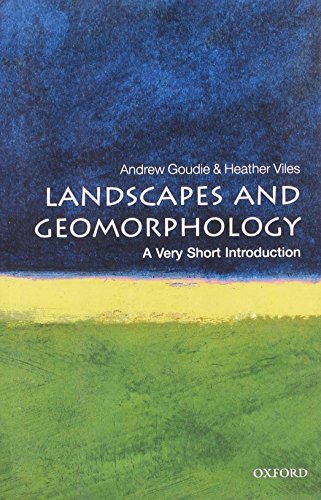
Sinossi
What were the landscapes of the past like? What will landscapes look like in the future?
Landscapes are all around us, but most of us know very little about how they have developed, what goes on in them, and how they react to changing climates, tectonics and human activities. Examining what landscape is, and how we use a range of ideas and techniques to study it, Andrew Goudie and Heather Viles demonstrate how geomorphologists have built on classic methods pioneered by some great 19th century scientists to examine our Earth.
Using examples from around the world, including New Zealand, the Tibetan Plateau, and the deserts of the Middle East, they examine some of the key controls on landscape today such as tectonics and climate, as well as humans and the living world. They also discuss some key 'landscape detectives' from the past, including Charles Darwin who did some important, but often overlooked, research on landscape.
Concluding with the cultural importance of landscape, and exploring how this has led to the conservation of much 'earth heritage', they delve into the future and look at how we can predict the response of landscapes to climate change in the future.
ABOUT THE SERIES: The Very Short Introductions series from Oxford University Press contains hundreds of titles in almost every subject area. These pocket-sized books are the perfect way to get ahead in a new subject quickly. Our expert authors combine facts, analysis, perspective, new ideas, and enthusiasm to make interesting and challenging topics highly readable.
Le informazioni nella sezione "Riassunto" possono far riferimento a edizioni diverse di questo titolo.
Informazioni sull?autore
Heather Viles is a geographer working in the University of Oxford, who teaches geomorphology to undergraduates and masters' level students, and researches on biological influences on geomorphology and the weathering of rocks and building stones. She is currently carrying out research in the Drakensberg Mountains, South Africa, the Namib desert, ruined ancient monuments in England, and is trying to simulate the weathering of rocks on the planet Mars in the laboratory.
Andrew Goudie is a Professor of Geography in the University of Oxford and Master of St Cross College. He has worked on many aspects of geomorphology including deserts, the effects of climate change, the links between geomorphology and archaeology, and the conservation of sites of geomorphological interest.
Le informazioni nella sezione "Su questo libro" possono far riferimento a edizioni diverse di questo titolo.
Risultati della ricerca per Landscapes and Geomorphology: A Very Short Introduction
Landscapes and Geomorphology: A Very Short Introduction (Very Short Introductions)
Da: WeBuyBooks, Rossendale, LANCS, Regno Unito
Condizione: Like New. Most items will be dispatched the same or the next working day. An apparently unread copy in perfect condition. Dust cover is intact with no nicks or tears. Spine has no signs of creasing. Pages are clean and not marred by notes or folds of any kind. Codice articolo rev3501120355
Compra usato
Quantità: 2 disponibili
Landscapes and Geomorphology : A Very Short Introduction
Da: Better World Books: West, Reno, NV, U.S.A.
Condizione: Very Good. Former library book; may include library markings. Used book that is in excellent condition. May show signs of wear or have minor defects. Codice articolo 7571040-6
Compra usato
Quantità: 1 disponibili
Landscapes and Geomorphology: A Very Short Introduction (Very Short Introductions)
Da: WorldofBooks, Goring-By-Sea, WS, Regno Unito
Paperback. Condizione: Very Good. The book has been read, but is in excellent condition. Pages are intact and not marred by notes or highlighting. The spine remains undamaged. Codice articolo GOR003406508
Compra usato
Quantità: 5 disponibili
Landscapes and Geomorphology: A Very Short Introduction
Da: Blue Vase Books, Interlochen, MI, U.S.A.
Condizione: good. Former library book with the usual stamps, stickers and labels. The item shows wear from consistent use, but it remains in good condition and works perfectly. All pages and cover are intact including the dust cover, if applicable . Spine may show signs of wear. Pages may include limited notes and highlighting. May NOT include discs, access code or other supplemental materials. Codice articolo BVV.0199565570.G
Compra usato
Quantità: 1 disponibili
Landscapes and Geomorphology: A Very Short Introduction (Very Short Introductions)
Da: AwesomeBooks, Wallingford, Regno Unito
paperback. Condizione: Very Good. Landscapes and Geomorphology: A Very Short Introduction (Very Short Introductions) This book is in very good condition and will be shipped within 24 hours of ordering. The cover may have some limited signs of wear but the pages are clean, intact and the spine remains undamaged. This book has clearly been well maintained and looked after thus far. Money back guarantee if you are not satisfied. See all our books here, order more than 1 book and get discounted shipping. Codice articolo 7719-9780199565573
Compra usato
Quantità: 2 disponibili
Landscapes and Geomorphology
Da: Books Puddle, New York, NY, U.S.A.
Condizione: New. pp. [x] + 137 + [v] Index 1st Published. Codice articolo 261801007
Compra nuovo
Quantità: 4 disponibili
Landscapes and Geomorphology : A Very Short Introduction
Da: GreatBookPrices, Columbia, MD, U.S.A.
Condizione: New. Codice articolo 8810467-n
Compra nuovo
Quantità: 5 disponibili
Landscapes and Geomorphology A Very Short Introduction (Very Short Introductions)
Da: Lakeside Books, Benton Harbor, MI, U.S.A.
Condizione: New. Brand New! Not Overstocks or Low Quality Book Club Editions! Direct From the Publisher! We're not a giant, faceless warehouse organization! We're a small town bookstore that loves books and loves it's customers! Buy from Lakeside Books! Codice articolo OTF-S-9780199565573
Compra nuovo
Quantità: 14 disponibili
Landscapes and Geomorphology
Print on DemandDa: Majestic Books, Hounslow, Regno Unito
Condizione: New. pp. [x] + 137 + [v] Illus. This item is printed on demand. Codice articolo 7128304
Compra nuovo
Quantità: 4 disponibili
Landscapes and Geomorphology : A Very Short Introduction
Da: GreatBookPrices, Columbia, MD, U.S.A.
Condizione: As New. Unread book in perfect condition. Codice articolo 8810467
Compra usato
Quantità: 5 disponibili
